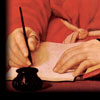 | Third Edition (2013) of the MHRA Style GuideWarning: now out of date. See the contents page for why. |
14 Proof Correction
It is common for proofs to be emailed as PDF files rather than sent as hard copy. The author should consult with the editor whether proofs should be printed off and changes marked on the hard copy, or whether they may be communicated in a list in a separate email.
Make all corrections distinctly in ink in the margins; marks made in the text should be those indicating the place to which the correction refers and should not obliterate the text to be corrected. An alteration is made by striking through, or marking as indicated in the table below, the character(s) or word(s) to be altered, and writing the new material in the margin, followed by a concluding stroke ( / ). If several corrections occur in one line they should be divided between left and right margins, the order being from left to right in each margin; individual marks should be separated by a concluding stroke. Author corrections should be avoided at proof stage. However, if such changes are essential, authors should be aware that substantial additions or deletions will affect layout and pagination and the editor may insist on further changes within the page to compensate for the text added or deleted. Publishers and journals may reserve the right to charge for substantial changes.
When checking final proofs, ensure not only that each correction marked on earlier proofs has been made, but also that no further errors have been introduced during the process of correction. Check line endings, page breaks, running heads, and page numbers carefully. It is safer to check these points as a separate operation after reading through the proofs in the normal way.
Normally only matter to be substituted for, or added to, the existing text should be written on the proof. If, however, there are any problems or comments to be brought to the attention of the printer, they should be written on the proof, encircled, and preceded by the word ‘PRINTER’ (in capitals). Do not give lengthy directions to the printer when a simple proof-correction mark will suffice. Proof-correction marks should follow BS 5261C:2005: Marks for Copy Preparation and Proof Correction (London: British Standards Institution, 2005). The print edition of the Style Guide contains a table of these markings, but for copyright reasons it cannot be reproduced here.
Contents • Back to 13 Useful Works of Reference • Forward to I2 Index • Index